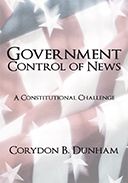
 |
With the advent of television came the opportunity to share information both through audio and video and reach people immediately. Though the First Amendment to the United States Constitution protects the freedom of the press from government influence, a surprising Supreme Court ruling upheld the Federal Communications Commission’s Fairness Doctrine. This rule imposed a requirement for television stations to provide equal airtime to differing opinions on controversial issues. While it was written in order to encourage fairness as its name implies, what it ended up accomplishing was allowing the government to meddle in issues that it was constitutionally prohibited from involvement in. While the Fairness Doctrine was eventually abandoned, there are still those in government who wish to restrict the freedom of the press, and this book examines the history of such efforts as well as new threats to a free press on the horizon.
The expertise of the author is on full display in this book as he worked both as a First Amendment lawyer and a legal executive for a television network. With intimate knowledge of the intersection of television news and First Amendment rights, the history of both is explored in depth. In addition to that history and the author’s opinions on more modern concerns, there is a wealth of reference materials including an extensive bibliography and excerpts from the rulings discussed in the book. While the rulings discussed happened decades ago, the subject material of this book is very timely considering the issues surrounding journalism and the news currently. Anyone interested in a lesser-known piece of American history or the precedents that lead to current affairs will find the information in this book expertly written and fascinatingly informative.